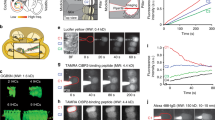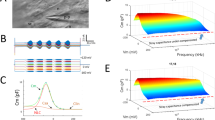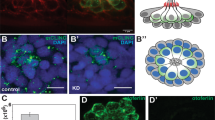Abstract
Mammalian cochlear inner hair cells (IHCs) are specialized for the dynamic coding of continuous and finely graded sound signals. This ability is largely conferred by the linear Ca2+ dependence of neurotransmitter release at their synapses, which is also a feature of visual and olfactory systems. The prevailing hypothesis is that linearity in IHCs occurs through a developmental change in the Ca2+ sensitivity of synaptic vesicle fusion from the nonlinear (high order) Ca2+ dependence of immature spiking cells. However, the nature of the Ca2+ sensor(s) of vesicle fusion at hair cell synapses is unknown. We found that synaptotagmin IV was essential for establishing the linear exocytotic Ca2+ dependence in adult rodent IHCs and immature outer hair cells. Moreover, the expression of the hitherto undetected synaptotagmins I and II correlated with a high-order Ca2+ dependence in IHCs. We propose that the differential expression of synaptotagmins determines the characteristic Ca2+ sensitivity of vesicle fusion at hair cell synapses.
This is a preview of subscription content, access via your institution
Access options
Subscribe to this journal
Receive 12 print issues and online access
$209.00 per year
only $17.42 per issue
Buy this article
- Purchase on Springer Link
- Instant access to full article PDF
Prices may be subject to local taxes which are calculated during checkout







Similar content being viewed by others
References
Fuchs, P.A. Time and intensity coding at the hair cell's ribbon synapse. J. Physiol. (Lond.) 566, 7–12 (2005).
Moser, T., Neef, A. & Khimich, D. Mechanisms underlying the temporal precision of sound coding at the inner hair cell ribbon synapse. J. Physiol. (Lond.) 576, 55–62 (2006).
Juusola, M., French, A.S., Uusitalo, R.O. & Weckström, M. Information processing by graded-potential transmission through tonically active synapses. Trends Neurosci. 19, 292–297 (1996).
Sterling, P. & Matthews, G. Structure and function of ribbon synapses. Trends Neurosci. 28, 20–29 (2005).
Glowatzki, E. & Fuchs, P.A. Transmitter release at the hair cell ribbon synapse. Nat. Neurosci. 5, 147–154 (2002).
Singer, J.H., Lassová, L., Vardi, N. & Diamond, J.S. Coordinated multivesicular release at a mammalian ribbon synapse. Nat. Neurosci. 7, 826–833 (2004).
Johnson, S.L., Marcotti, W. & Kros, C.J. Increase in efficiency and reduction in Ca2+ dependence of exocytosis during development of mouse inner hair cells. J. Physiol. (Lond.) 563, 177–191 (2005).
Thoreson, W.B., Rabl, K., Townes-Anderson, E. & Heidelberger, R. A highly Ca2+-sensitive pool of vesicles contributes to linearity at the rod photoreceptor ribbon synapse. Neuron 42, 595–605 (2004).
Johnson, S.L., Forge, A., Knipper, M., Münkner, S. & Marcotti, W. Tonotopic variation in the calcium dependence of neurotransmitter release and vesicle pool replenishment at mammalian auditory ribbon synapses. J. Neurosci. 28, 7670–7678 (2008).
Marcotti, W. & Kros, C.J. Developmental expression of the potassium current IK,n contributes to maturation of the mouse outer hair cells. J. Physiol. (Lond.) 520, 653–660 (1999).
Beurg, M. et al. Calcium- and otoferlin-dependent exocytosis by immature outer hair cells. J. Neurosci. 28, 1798–1803 (2008).
Johnson, S.L., Franz, C., Knipper, M. & Marcotti, W. Functional maturation of the exocytotic machinery at gerbil hair cell ribbon synapses. J. Physiol. (Lond.) 587, 1715–1726 (2009).
Lenzi, D. & von Gersdorff, H. Structure suggests function: the case for synaptic ribbons as exocytotic nanomachines. Bioessays 23, 831–840 (2001).
Glowatzki, E., Grant, L. & Fuchs, P.A. Hair cell afferent synapses. Curr. Opin. Neurobiol. 18, 389–395 (2008).
Safieddine, S. & Wenthold, R.J. SNARE complex at the ribbon synapses of cochlear hair cells: analysis of synaptic vesicle- and synaptic membrane-associated proteins. Eur. J. Neurosci. 11, 803–812 (1999).
Südhof, T.C. The synaptic vesicle cycle. Annu. Rev. Neurosci. 27, 509–547 (2004).
Roux, I. et al. Otoferlin, defective in a human deafness form, is essential for exocytosis at the auditory ribbon synapse. Cell 127, 277–289 (2006).
Brandt, N. et al. Thyroid hormone deficiency affects postnatal spiking activity and expression of Ca2+ and K+ channels in rodent inner hair cells. J. Neurosci. 27, 3174–3186 (2007).
Heidrych, P. et al. Otoferlin interacts with myosin VI: implications for maintenance of the basolateral synaptic structure of the inner hair cell. Hum. Mol. Genet. 18, 2779–2790 (2009).
Südhof, T.C. Synaptotagmins: why so many? J. Biol. Chem. 277, 7629–7632 (2002).
Dean, C. et al. Synaptotagmin-IV modulates synaptic function and long-term potentiation by regulating BDNF release. Nat. Neurosci. 12, 767–776 (2009).
Littleton, J.T., Serano, T.L., Rubin, G.M., Ganetzky, B. & Chapman, E.R. Synaptic function modulated by changes in the ratio of synaptotagmin I and IV. Nature 400, 757–760 (1999).
Zhang, Q., Fukuda, M., Van Bockstaele, E., Pascual, O. & Haydon, P.G. Synaptotagmin IV regulates glial glutamate release. Proc. Natl. Acad. Sci. USA 101, 9441–9446 (2004).
Ferguson, G.D., Anagnostaras, S.G., Silva, A.J. & Herschman, H.R. Deficits in memory and motor performance in synaptotagmin IV mutant mice. Proc. Natl. Acad. Sci. USA 97, 5598–5603 (2000).
Brandt, A., Khimich, D. & Moser, T. Few CaV1.3 channels regulate the exocytosis of a synaptic vesicle at the hair cell ribbon synapse. J. Neurosci. 25, 11577–11585 (2005).
Sobkowicz, H.M., Rose, J.E., Scott, G.E. & Slapnick, S.M. Ribbon synapses in the developing intact and cultured organ of Corti in the mouse. J. Neurosci. 2, 942–957 (1982).
Dallos, P. The active cochlea. J. Neurosci. 12, 4575–4585 (1992).
Knirsch, M. et al. Persistence of CaV1.3 Ca2+ channels in mature outer hair cells supports outer hair cell afferent signaling. J. Neurosci. 27, 6442–6451 (2007).
Johnson, S.L., Adelman, J.P. & Marcotti, W. Genetic deletion of SK2 channels in mouse inner hair cells prevents the developmental linearization in the Ca2+ dependence of exocytosis. J. Physiol. (Lond.) 583, 631–646 (2007).
Dulon, D., Safieddine, S., Jones, S.M. & Petit, C. Otoferlin is critical for a highly sensitive and linear calcium-dependent exocytosis at vestibular hair cell ribbon synapses. J. Neurosci. 29, 10474–10487 (2009).
Shin, O.H., Xu, J., Rizo, J. & Südhof, T.C. Differential but convergent functions of Ca2+ binding to synaptotagmin-1 C2 domains mediate neurotransmitter release. Proc. Natl. Acad. Sci. USA 106, 16469–16474 (2009).
Vician, L. et al. Synaptotagmin IV is an immediate early gene induced by depolarization in PC12 cells and in brain. Proc. Natl. Acad. Sci. USA 92, 2164–2168 (1995).
Ting, J.T., Kelley, B.G. & Sullivan, J.M. Synaptotagmin IV does not alter excitatory fast synaptic transmission or fusion pore kinetics in mammalian CNS neurons. J. Neurosci. 26, 372–380 (2006).
Murphy, G.J., Glickfeld, L.L., Balsen, Z. & Isaacson, J.S. Sensory neuron signaling to the brain: properties of transmitter release from olfactory nerve terminals. J. Neurosci. 24, 3023–3030 (2004).
Zhang, Z., Bhalla, A., Dean, C., Chapman, E.R. & Jackson, M.B. Synaptotagmin IV: a multifunctional regulator of peptidergic nerve terminals. Nat. Neurosci. 12, 163–171 (2009).
Wang, C.-T. et al. Different domains of synaptotagmin control the choice between kiss-and-run and full fusion. Nature 424, 943–947 (2003).
Mackler, J.M., Drummond, J.A., Loewen, C.A., Robinson, I.M. & Reist, N.E. The C(2)B Ca2+-binding motif of synaptotagmin is required for synaptic transmission in vivo. Nature 418, 340–344 (2002).
Geppert, M. et al. Synaptotagmin I: a major Ca2+ sensor for transmitter release at a central synapse. Cell 79, 717–727 (1994).
Pang, Z.P. et al. Synaptotagmin-2 is essential for survival and contributes to Ca2+ triggering of neurotransmitter release in central and neuromuscular synapses. J. Neurosci. 26, 13493–13504 (2006).
Littleton, J.T., Stern, M., Perin, M. & Bellen, H.J. Calcium dependence of neurotransmitter release and rate of spontaneous vesicle fusions are altered in Drosophila synaptotagmin mutants. Proc. Natl. Acad. Sci. USA 91, 10888–10892 (1994).
Chapman, E.R., Desai, R.C., Davis, A.F. & Tornehl, C.K. Delineation of the oligomerization, AP-2 binding and synprint binding region of the C2B domain of synaptotagmin. J. Biol. Chem. 273, 32966–32972 (1998).
Thomas, D.M., Ferguson, G.D., Herschman, H.R. & Elferink, L.A. Functional and biochemical analysis of the C2 domains of synaptotagmin IV. Mol. Biol. Cell 10, 2285–2295 (1999).
Stevens, C.F. & Sullivan, J.M. The synaptotagmin C2A domain is part of the calcium sensor controlling fast synaptic transmission. Neuron 39, 299–308 (2003).
Nagy, G. et al. Different effects on fast exocytosis induced by synaptotagmin 1 and 2 isoforms and abundance but not by phosphorylation. J. Neurosci. 26, 632–643 (2006).
Xu, J., Mashimo, T. & Südhof, T.C. Synaptotagmin-1, -2 and -9: Ca2+ sensors for fast release that specify distinct presynaptic properties in subsets of neurons. Neuron 54, 567–581 (2007).
Moody, W.J. & Bosma, M.M. Ion channel development, spontaneous activity, and activity-dependent development in nerve and muscle cells. Physiol. Rev. 85, 883–941 (2005).
Gu, X. & Spitzer, N.C. Distinct aspects of neuronal differentiation encoded by frequency of spontaneous Ca2+ transients. Nature 375, 784–787 (1995).
Marcotti, W., Johnson, S.L., Holley, M.C. & Kros, C.J. Developmental changes in the expression of potassium currents of embryonic, neonatal and mature mouse inner hair cells. J. Physiol. (Lond.) 548, 383–400 (2003).
Lenzi, D., Runyeon, J.W., Crum, J., Ellisman, M.K. & Roberts, W.M. Synaptic vesicle populations in saccular hair cells reconstructed by electron tomography. J. Neurosci. 19, 119–132 (1999).
Furness, D.N. & Hackney, C.M. Cross-links between stereocilia in the guinea pig cochlea. Hear. Res. 18, 177–188 (1985).
Acknowledgements
We would like to thank M.C. Holley and E. Smythe for their critical feedback on an earlier version of the manuscript. We would also like to thank A. Catapang for help with genotyping, M. Cardwell and A. Davids for their assistance with the breeding of Syt IV animals, and K. Rohbock and S. Kasperek for their technical assistance with the immunolabeling experiments. The rSytIV pIE construct was obtained from Addgene. This work was supported by grants from the Wellcome Trust, Deafness Research UK, University of Sheffield Devolved Funds and The Royal Society to W.M., Deutsche Forschungsgameinschft 316-4-1 to M.K., and the Baden-Württemberg Graduate Programme of the University of Tübingen to M.K. and J.E. W.M. is a Royal Society University Research Fellow.
Author information
Authors and Affiliations
Contributions
S.L.J. carried out the electrophysiological experiments and analysis, and helped to design the experiments and to write the paper. C.F. and J.E. performed the immunolabeling and in situ hybridization experiments. D.N.F. carried out the TEM experiments. L.R. performed hearing measurements. S.K., M.N.R., J.E., E.P.S., S.M. and H.R.H. were involved in study design and data interpretation. S.L.J. had the initial idea for the possible involvement of Syt IV in IHC synaptic activity. M.K. supervised and analyzed immunolabeling experiments. W.M. and M.K. designed the research. W.M. conceived and coordinated the study, supervised the experiments, participated in data collection and analysis, and wrote the paper. All authors discussed the results and commented on the manuscript.
Corresponding author
Supplementary information
Supplementary Text and Figures
Supplementary Figures 1–7 and Supplementary Tables 1 and 2 (PDF 1626 kb)
Rights and permissions
About this article
Cite this article
Johnson, S., Franz, C., Kuhn, S. et al. Synaptotagmin IV determines the linear Ca2+ dependence of vesicle fusion at auditory ribbon synapses. Nat Neurosci 13, 45–52 (2010). https://doi.org/10.1038/nn.2456
Received:
Accepted:
Published:
Issue Date:
DOI: https://doi.org/10.1038/nn.2456
This article is cited by
-
RBP2 stabilizes slow Cav1.3 Ca2+ channel inactivation properties of cochlear inner hair cells
Pflügers Archiv - European Journal of Physiology (2020)
-
Injured astrocytes are repaired by Synaptotagmin XI-regulated lysosome exocytosis
Cell Death & Differentiation (2016)
-
Reciprocal inhibition between sensory ASH and ASI neurons modulates nociception and avoidance in Caenorhabditis elegans
Nature Communications (2015)
-
Specific synaptopathies diversify brain responses and hearing disorders: you lose the gain from early life
Cell and Tissue Research (2015)
-
Regenerated Synapses Between Postnatal Hair Cells and Auditory Neurons
Journal of the Association for Research in Otolaryngology (2013)



